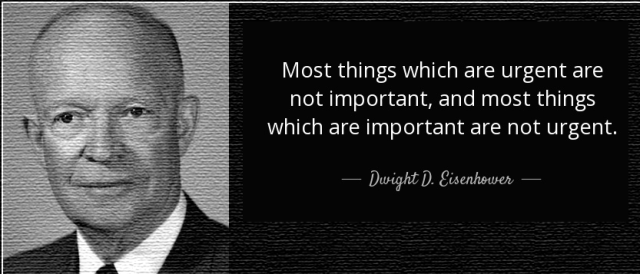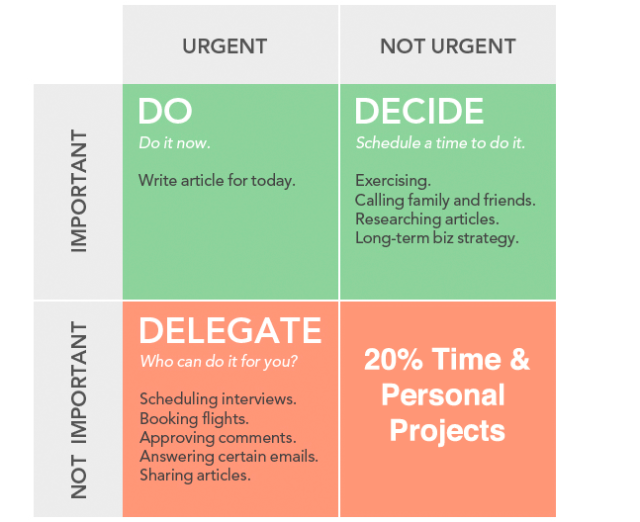What is Important is Seldom Urgent
By: Tony DePrato | Follow me on Twitter @tdeprato
Before jumping into this post, here is some background on former President of the United States, Dwight D. Eisenhower who developed the methods discussed below. I found an excellent synopsis for those unfamiliar with his legacy and prominence:
Eisenhower was the 34th President of the United States, serving two terms from 1953 to 1961. During his time in office, he launched programs that directly led to the development of the Interstate Highway System in the United States, the launch of the internet (DARPA), the exploration of space (NASA), and the peaceful use of alternative energy sources (Atomic Energy Act).
Before becoming president, Eisenhower was a five-star general in the United States Army, served as the Supreme Commander of the Allied Forces in Europe during World War II, and was responsible for planning and executing invasions of North Africa, France, and Germany.
At other points along the way, he served as President of Columbia University, became the first Supreme Commander of NATO, and somehow found time to pursue hobbies like golfing and oil painting.
Eisenhower had an incredible ability to sustain his productivity not just for weeks or months, but for decades. And for that reason, it is no surprise that his methods for time management, task management, and productivity have been studied by many people.
Step Into the Matrix
There are many methods used for time and project management. President Eisenhower group things into simple categories so that he could efficiently and quickly prioritise his work life. Because of his great success, a model was developed from his methods and applied to the business world. The model is known as The Eisenhower Matrix.
 The original model is reflected in the four quadrants above, and it is self explanatory.
The original model is reflected in the four quadrants above, and it is self explanatory.
The bottom right category would require those items to be removed completely. Although I am no Eisenhower, I did take it upon myself to alter the bottom right corner. Instead of using it to DELETE tasks or to categorize tasks as “useless”, I use to to track personal projects or 20% Time Projects. After all, if something is useless, it stays outside the box.
My box looks like this:
The most important thing to remember is that everything cannot be urgent and important. If the majority of your day-to-day work-life is in the upper left quadrant, then something is wrong and out-of-balance.
Most tasks that fall into a person’s normal set of responsibilities should be in the upper right quadrant. Tasks or jobs in the lower left quadrant are often things assigned by a superior, that fall outside of the normal set of responsibilities or favours you might be doing for others.
Examples From My Personal Matrix
Important Not Urgent:
- Develop a new class schedule before March 20th
- Create a new html template for Power School effort reports by March 18th
- Review email branding process before April 15th
Notice all of the above have due dates that fall within the next 7-30 days of this post’s publication. I have had them in the list for awhile. The deadline is approaching but these were all planned.
Important and Urgent:
- Buy music software for upcoming performance
- Develop new Sharepoint email workflow for Human Resources
These items are IT support items which have been assigned to me from other departments.
These need to be completed immediately. I am required to do these tasks, but they were not planned, and the notice was short. If I could not complete these items, or if I thought they would negatively impact items in the upper right quadrant, I might have to delegate them or exclude them.
Not Important but Urgent (Delegate):
- Telescope delivery
- Hand out ID cards
- Documents archive packaged for accreditation team
These are all jobs anyone in my department can do. All are very time consuming. I need to make certain they are finished, but I should not be doing these myself. Occasionally this quadrant contains a task I am required to do, but that task literally has nothing to do with my job.
Not Important / Not Urgent /Ideas / 20% Time
- Redesign interface for Moodle
- Improve code for iTunes based video streaming
These are projects I enjoy doing. If they never get finished, no one will be the wiser. The systems impacted are already fully functional. The skills learned from working on projects like these often transfer to other areas. 20% time projects are excellent for professional development and often lead to exciting random discoveries.
Tools for Getting Started
A simple way to apply the Eisenhower Matrix is to use Evernote or OneNote. Office software also works. However, keeping a record of all the data and reflecting on it after the school year can be tricky. I recommended using software like Priority Matrix. The interface is simple, and the software links to Evernote.
 Appfluence Priority Matrix
Appfluence Priority Matrix
Last year I produced a list of all the scheduled items I had completed from January to June. I was amazed not only at the variety of projects and jobs I had been involved with, but also how many should have been placed in that lower left quadrant (Delegation). I have used that data to consciously delegate more tasks.
Before beginning, I recommend organising your team together to discuss what types of projects, jobs, etc. would fall into each quadrant. Have each member bring a list of everything they have been working on for the last thirty days. Use that data to fill in the box by reaching group consensus.
If nothing else, the Eisenhower Matrix makes the mind slow down and focus. The matrix forces reflection and constantly reminds users that most things are not urgent, nor important. Stress and circumstance can often cloud judgements and shift focus away from where it should be- Students & Learning.
Tony DePrato


You must be logged in to post a comment.